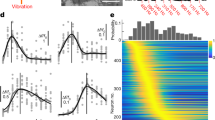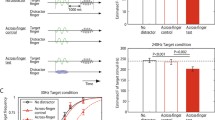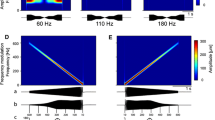Summary
We have studied the response properties of peripheral myelinated fibers ending in the hairy skin of the Rhesus monkey, activated by sinusoidal mechanical stimulation. In parallel experiments we measured thresholds of the sensations evoked in man by identical stimuli, delivered under similar conditions to corresponding areas of the hairy skin. We found that the sense of low frequency vibration (i. e., flutter) depends upon activity in rapidly adapting alpha fibers which end in or about the hair follicles. High frequency vibration is signalled by Pacinian afferents whose terminals lie deep to the skin itself. These two sets of fibers, by reason of their discharge patterns and differential sensitivities in different frequency ranges, are thought to provide the essential first order input for the human sense of vibration evoked by stimulation of the hairy skin. Rapidly adapting cutaneous afferents of the delta size and two classes of slowly adapting alpha fibers are also entrained by mechanical sinusoids, but are thought not to contribute to vibratory sensibility. Our findings support the proposition that the sensitivity of humans to oscillatory mechanical stimuli at different frequencies, and the quality of the sensations evoked by them, are determined in the first instance by the properties of two distinct sets of peripheral afferent fibers.
Similar content being viewed by others
References
Andersson, S.A.: Projection of different spinal pathways to the second somatic sensory area in cat. Acta physiol. scand. 56, Suppl. 194 (1962).
Békésy, G. von: Über die Vibrationsempfindung. Akust. Zeit. 4, 316–334 (1939).
—: Sensory Inhibition. Princeton/N.J.: Princeton University Press 1967.
Brown, A.G., and A. Iggo: A quantitative study of cutaneous receptors and afferent fibers in the cat and rabbit. J. Physiol. (Lond.) 193, 707–733 (1967).
Bugard, P.J.: Mesure des seuils de sensation vibratoire chez l'homme. J. Physiol. Path. gén. 44, 230–233 (1952).
Burgess, P.R., D. Petit and B.M. Warren: Receptor types in cat hairy skin supplied by myelinated fibers. J, Neurophysiol. 31, 833–848 (1968).
Calne, D.B., and C.A. Pallis: Vibratory sense: A critical review. Brain 89, 723–746 (1966).
Chambers, M.R., and A. Iggo: Slowly-adapting cutaneous mechanoreceptors. J. Physiol. (Lond.) 192, 26–27P (1967).
Cohen, L.H., and S.B. Lindley: Studies in vibratory sensibility. Amer. J. Psychol. 51, 44–63 (1938).
Egger, M.: De la sensibilité osseuse. J. Physiol. Path. gén. 1, 511–520 (1899).
Frank, C.: Die Störungen des Vibrationsgefühls bei den traumatischen Verletzungen der peripheren Nervenstämme. Arch. Psychiat. Nervenkr. 62, 627–727 (1921).
Franke, E.K., H.E. von vGierke, H.L. Oestricher and W.W. von vWittern: The propagation of surface waves over the human body. A.F. Technical Report No. 6464, Air Materiel Command, Wright Patterson Air Force Base, Dayton, Ohio, 1951.
Frey, M. von: Physiologische Versuche über das Vibrationsgefühl. Z. Biol. 65, 417–427 (1915).
—: Die Tangoreceptoren des Menschen. In: Handbuch der normalen und pathologischen Physiologie, Bd. 13. Ed. by A. Bethe, G. von vBergman, G. Embden and A. Ellinger. Berlin: Springer 1926.
Geldard, F.A.: The perception of mechanical vibration: I. History of a controversy. J. Gen. Psychol. 22, 243–269 (1940a).
—: The perception of mechanical vibration: II. The response of pressure receptors. J. Gen. Psychol. 22, 271–280 (1940b).
—: The perception of mechanical vibration: III. The frequency function. J. Gen. Psychol. 22, 281–289 (1940c).
—: The perception of mechanical vibration: IV. Is there a separate “vibratory sense”? J. Gen. Psychol. 22, 291–308 (1940d).
Goldscheider, A.: Über das Vibrationsgefübl. Berl. klin. Wschr. 41, 353–359 (1904).
Gray, R.C.: A quantitative study of vibration sense in normal and pernicious anemia cases. Minn. Med. 15, 674–697 (1932).
Hunt, C.C.: On the nature of vibration receptors in the hind limb of the cat. J. Physiol. (Lond.) 155, 175–186 (1961).
—, and A.K. McIntyre: Characteristics of responses from receptors from the flexor longus digitorium muscle and the adjoining interosseus region of the cat. J. Physiol. (Lond.) 153, 74–87 (1960).
Iggo, A.: An electrophysiological analysis of afferent fibers in primate skin. Acta neuroveg. (Wien) 24, 225–240 (1963).
—: Cutaneous receptors with a high sensitivity to mechanical displacement. In: Touch, Heat and Pain. Ed. by. A. de vReuck and J. Knight. Boston: Little Brown 1966.
Laidlaw, R.W., and M.A. Hamilton: Thresholds of vibratory sensibility as determined by the pallesthesiometer. Bull. neurol. Inst. N.Y. 6, 494–503 (1937).
Lindblom, U.: Properties of touch receptors in distal glabrous skin of the monkey. J. Neurophysiol. 28, 966–985 (1965).
—, and L. Lund: The discharge from vibration sensitive receptors in the monkey foot. Exp. Neurol. 15, 401–417 (1966).
—, and D.N. Tapper: Terminal properties of a vibro-tactile sensor. Exp. Neurol. 17, 1–15 (1967).
McIntyre, A.K.: Perception of vibration. Proc. Aust. Ass. Neurol. 3, 71–76 (1962).
Merzenich, M.M.: Some Observations on the Encoding of Somesthetic Stimuli by Receptor Populations in the Hairy Skin of Primates. Doctoral Thesis, The Johns Hopkins University. Baltimore, Maryland, 1968.
Miller, M.R., H.J. Ralston and K. Michiko: The pattern of cutaneous innervation of the human hand. Amer. J. Anat. 102, 183–218 (1958).
Mountcastle, V.B.: The problem of sensing and the neural coding of sensory events. In: The Neurosciences. Ed. by G.C. Quarton, I. Melnechuk and F.O. Schmitt. New York: Rockefeller Press 1967.
—, G.F. Poggio and G. Werner: The relation of thalamic cell response to peripheral stimuli varied over an intensive continuum. J. Neurophysiol. 26, 807–834 (1963).
—, W.H. Talbot, H. Sakata and J. Hyvarinen: Cortical neuronal mechanisms in flutter vibration studied in unanesthetized monkeys. Neuronal periodicity and frequency discrimination. J. Neurophysiol. 32, 452–484 (1969).
Newman, H.W., J. Doupe and R.W. Wilkins: Some observations on the nature of vibratory sensibility. Brain 62, 31–40 (1939).
Nilsson, B.Y., and C.R. Skoglund: The tactile hairs on the cat's foreleg. Acta physiol. scand. 65, 364–369 (1965).
Perl, E.R.: Etudes sur la sensibilité tactile et sur la sensibilité vibratoire. Actualities neurophysiol. 5, 91–110 (1964).
—: Myelinated afferent fibers innervating the primate skin and their response to noxious stimuli, J. Physiol. (Lond.) 197, 593–615 (1968).
Pfaffman, C.: Afferent impulses from the teeth resulting from a vibratory stimulus. J. Physiol. (Lond.) 97, 220–232 (1939).
Pinkus, F.: Über Hautsinnesorgane neben dem menschlichen Haar (Haarscheiben) und ihre vergleichend-anatomische Bedeutung. Arch. mikr. Anat. 65, 121–179 (1905).
Poggio, G.F., and V.B. Mountcastle: The functional properties of ventrobasal thalamic neurons studied in unanesthetized monkeys. J. Neurophysiol. 26, 775–806 (1963).
Rein, H.: Die Anwendung der Elektrophorese zur Local-Anästhesie. Z. Biol. 81, 141–160 (1924).
Rubin, E.: Quelques expériences sur les rapports entre les domaines auditif et tactile vibratoire. J. Psychol. norm. path. 35, 19–25 (1938).
Sato, M.: Response of Pacinian corpuscles to sinusoidal vibration. J. Physiol. (Lond.) 159, 391–409 (1961).
Schwartzman, R.J., and M.D. Bogdanoff: Behavioral and anatomical analysis of vibration sensibility. Exp. Neurol. 20, 43–51 (1968).
Sherrick, C.E., jr.: Variables affecting sensitivity of the human skin to mechanical vibration. J. exp. Psychol. 45, 273–282 (1953).
Stevens, S.S.: The psychophysics of sensory function. In: Sensory Communication. Ed. by W.A. Rosenblith. Cambridge/Mass.: MIT Press 1959a.
—: Tactile vibration: Dynamics of sensory intensity. J. exp. Psychol. 57, 210–318 (1959b).
—: Tactile vibration: Change of exponent with frequency. Percept. and Psychophys. 3, 223–228 (1968).
Stopford, J.S.B.: The variation in distribution of the cutaneous nerves of the hand and digits. J. Anat. (Lond.) 53, 14–25 (1918).
Talbot, W.H., I. Darian-Smith, H.H. Kornhuber and V.B. Mountcastle: The sense of flutter-vibration: Comparison of the human capacity with response patterns of mechanoreceptive afferents from the monkey hand. J. Neurophysiol. 31, 301–334 (1968).
Uddenberg, N.: Differential localization in dorsal funiculus of fibers originating from different receptors. Exp. Brain Res. 4, 367–376 (1968).
Vasilevskii, N.N., Z.A. Aleksanyan and S.I. Soroko: Activity evoked in cortical neurons and primary cutaneous afferent fibers by vitratory stimulation. Neurosci. Trans. 1, 259–267 (1968).
Verrillo, R.T.: Vibrotactile thresholds for hairy skin. J. exp. Psychol. 72, 47–50 (1966a).
—: Effects of spatial parameters on the vibrotactile threshold. J. exp. Psychol. 71, 570–575 (1966b).
—: A duplex mechanism of mechanoreception. In: The Skin Senses. Ed. by D. Kenshalo. Springfield/Ill.: C.C. Thomas 1968.
Wall, P.D., and J.R. Cronley-Dillon: Pain, itch, and vibration. Arch. Neurol. (Chic.) 2, 365–375 (1960).
Werner, G., and V.B. Mountcastle: Neural activity in mechanoreceptive cutaneous afferents: Stimulus-response relations, Weber functions, and information transmission. J. Neurophysiol. 28, 359–397 (1965).
Wilska, A.: On the vibrational sensitivity in different regions of the body surface. Acta physiol. scand. 31, 285–289 (1954).
Winkelman, R.K.: Nerve Endings in Normal and Pathologic Skin: Contributions to the Anatomy of Sensations. Springfield/Ill.: C. C. Thomas 1960.
Author information
Authors and Affiliations
Additional information
Supported in part by training and research grants from the United States Public Health Service, No's 1-PO1-NB-06828, TO1-GM-00443, and 5-TO1-NB-0523.
The research described in this paper was submitted by Dr. Merzenich in partial fulfillment of the requirements for the degree of Doctor of Philosophy, The Johns Hopkins University, June, 1968.
Rights and permissions
About this article
Cite this article
Merzenich, M.M., Harrington, T. The sense of flutter-vibration evoked by stimulation of the hairy skin of primates: Comparison of human sensory capacity with the responses of mechanoreceptive afferents innervating the hairy skin of monkeys. Exp Brain Res 9, 236–260 (1969). https://doi.org/10.1007/BF00234457
Received:
Issue Date:
DOI: https://doi.org/10.1007/BF00234457




